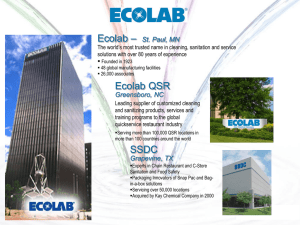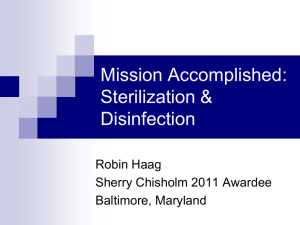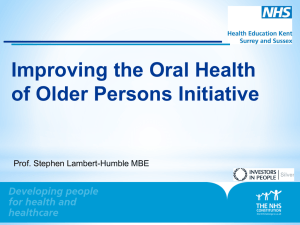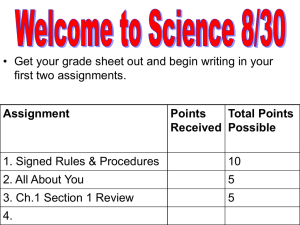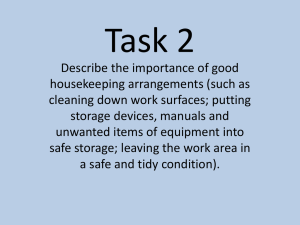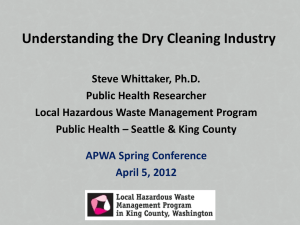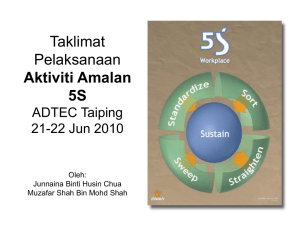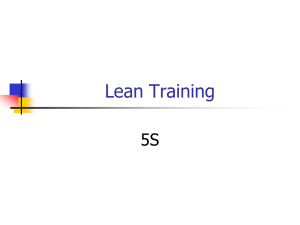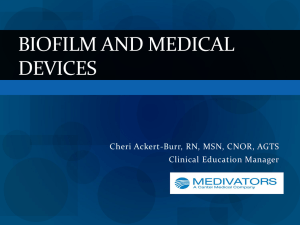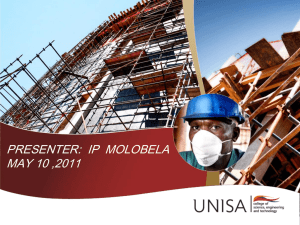Annie-QLD-SRACA
advertisement
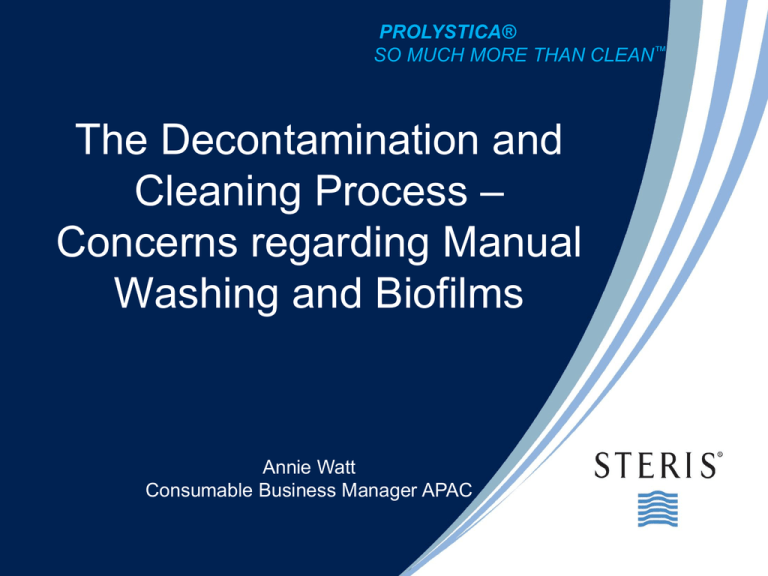
PROLYSTICA® SO MUCH MORE THAN CLEAN™ The Decontamination and Cleaning Process – Concerns regarding Manual Washing and Biofilms Annie Watt Consumable Business Manager APAC PROLYSTICA® SO MUCH MORE THAN CLEAN™ What should we be monitoring routinely? • • • • • • Automated washers Manual washing Water Detergents Instrument protection Washer protection 2 PROLYSTICA® SO MUCH MORE THAN CLEAN™ What can we do to reduce the risk? • • • • Safe Transport Cleaning Disinfection Sterilization PROLYSTICA® SO MUCH MORE THAN CLEAN™ PROLYSTICA® SO MUCH MORE THAN CLEAN™ Cleaning Processes • Cleaning and disinfection of medical devices is regulated by: – – – – – Medical Device Directive Recommendations of National Authorities National Guidelines – AS/NZ4187 EN ISO 15883 ISO17664 5 PROLYSTICA® SO MUCH MORE THAN CLEAN™ ISO 15883 • Washer-Disinfectors – ‘machine intended to clean and disinfect medical devices and other articles’ • Performance requirements for washer-disinfectors and their accessories that are intended to be used for cleaning and disinfection of re-usable medical devices and other articles used in the context of medical, dental, pharmaceutical and veterinary practice ISO 15883 • Published standards – Part 1: General requirements, definitions and tests – Part 2: Washer-disinfectors employing thermal disinfection for surgical instruments, etc. – Part 3: Washer-disinfectors employing thermal disinfection for human waste containers – Part 4: Washer-disinfectors employing chemical disinfection for thermo-labile endoscopes – Part 6: Washer-disinfectors employing thermal disinfection for noninvasive medical devices etc. • Published Technical Specification (TS) – Part 5 (2005): Test soils and methods for demonstrating cleaning efficacy of washer-disinfectors EN ISO 15883 • Under development – Part 7: Washer-disinfectors employing chemical disinfection for non-invasive, non-critical thermolabile devices/equipment – prEN 16442 Storage/drying cabinets for flexible endoscopes – Revision of Part 5: standard test soil and cleaning test method (ISO lead) • Proposal for ultrasonic washers PROLYSTICA® SO MUCH MORE THAN CLEAN™ Standards and Guidelines • Standards – ISO 17664: Sterilization of medical devices. Information to be provided by the manufacturer for the processing of resterilizable medical devices • ‘A validated method of manual cleaning shall be specified.’ • ‘At least one validated automated method using a washer-disinfector shall also be specified unless the medical device cannot withstand any such process, in which case a warning should be issued’ • Details of manufacturer's instructions – All channels brushed? PROLYSTICA® SO MUCH MORE THAN CLEAN™ ISO 17664 3.1 Reprocessing instructions At least one validated method for reprocessing the medical device shall be specified. The following information shall be stated where it is critical to the maintenance of the intended function of the medical device and the safety of the user(s) and the patient: Details of process steps; • A description of special equipment and/or accessories; • Specification of process parameters and their tolerances. PROLYSTICA® SO MUCH MORE THAN CLEAN™ ISO 17664 3.5 Cleaning A validated method of manual cleaning shall be specified. At least one validated automated method using a washer-disinfector shall also be specified unless the medical device cannot withstand any such process, in which case a warning should be issued. Where appropriate, at least the following information shall be included: • A description of the accessories required for cleaning process • Identification and concentration of chemicals required for cleaning • Identification of water quality to be used for the process • Limits and monitoring of chemical residues remaining on the device • Limits on temperature, concentration of solution(s), exposure time to be used • Process temperature(s) to be used • Techniques to be used including rinsing Why Cleaning is Important • Device damage • Visually unacceptable devices – Cancelled procedures • Ineffective disinfectionsterilisation – Microbial transmission – Prion disease transmission • Toxicity – Adverse patient reports PROLYSTICA® SO MUCH MORE THAN CLEAN™ PROLYSTICA® SO MUCH MORE THAN CLEAN™ Requirement for Cleaning • Water • Mechanical effects • Cleaning chemistry – Temperature – Concentration PROLYSTICA® SO MUCH MORE THAN CLEAN™ Cleaning Processes • Organic matter is typically made up of carbohydrate, lipid and protein and it is essential that this is removed prior to sterilization. • Proteins are generally unique in that they must be washed off surfaces with water at a temperature of ≤55ºC otherwise the protein can coagulate and become extremely difficult to remove. • By contrast, lipids require a high temperature for adequate removal, often in the presence of a surfactant (detergent). • Each stage of the washer disinfector cycle therefore has a role to play in the removal of this organic debris 14 The implication… PROLYSTICA® SO MUCH MORE THAN CLEAN™ Manual cleaning should be limited to only those items not compatible with the mechanical cleaning process What are Biofilms? • Biofilm is a generic term used to describe a sludge like material that develops in association with organic materials. • Biofilms result from a variety of sources, and negatively impact a number of industrial and medical applications. • Biofilm is composed of a densely packed group of microorganisms • Individual microorganisms bound together by a polymeric substance excreted by the microorganisms. • The polymeric substance forms an adhesive matrix that holds the biofilm together, allows it to attach to surfaces, and protects the colony forming the biofilm. • Encapsulation is believed to play a role in some antibiotic resistant infections. BIOFILMS Functional States Biofilms – how they form? • The polymeric substance excreted by the microorganisms is known as an extracellular polymeric substance (EPS). It is also commonly called an extracellular adhesive matrix. • A key aspect of biofilms is a complex interaction among the mircoorganisms. • A biofilm forms when individual microorganisms cease to exhibit individual, free floating behaviour, and begin to associate with each other, and a surface, and begin to act in concert with each other. • A biofilm grows by both simple cell division, and by new free floating microorganisms associating with the developing biofilm. • Biofilms usually develop on solid surfaces immersed in a liquid. What is Biofilm? A few hours A few days BIOFILMS • Four functional states – Attachment – Aggregation – Biofilm formation – Detachment • Biofilms are difficult to treat PROLYSTICA® SO MUCH MORE THAN CLEAN™ The Decontamination Process Decontamination is the process that renders contaminated items safe to use for their intended purpose and safe to handle with reasonable care. • A two step process – Begins with cleaning – Followed by a microbicidal process • Disinfection or • Sterilization 21 Decontamination Practices at Point of Use Importance of quick cleaning after use • It’s critical to start the decontamination process immediately after the surgeon is finished with the device, particularly if the device is complex. Blood remains encrusted on instruments. 22 Decontamination Practices at Point of Use STERIS Pre-Klenz – Transport Gel •Clings to instruments to maintain moisture during transport •Will not stain instruments •Broad material compatibility •Reduces extra weight and splashing •Don’t use foam as it restricts you from seeing what is in the tray 23 PROLYSTICA® SO MUCH MORE THAN CLEAN™ Contain & Transport Slide 56-picture Items should not be transported in liquid because of the risk of spills, the promotion of biofilm formation, and the possibility of employee injury from lifting heavy containers. 24 PROLYSTICA® SO MUCH MORE THAN CLEAN™ Manual Cleaning • 3 sink configuration – First sink: soak • Low sudsing – Second sink: wash – Third sink: rinse – Treated water for final rinsing (deionized, distilled, softened, or reverse osmosis) 25 PROLYSTICA® SO MUCH MORE THAN CLEAN™ Manual Cleaning Decontamination Area May be used for any device Most often used if devices are delicate, complex or cannot tolerate mechanical cleaning 26 PROLYSTICA® SO MUCH MORE THAN CLEAN™ Manual Cleaning • SOAPS to avoid – Housekeeping soaps – Laundry soaps – Surgeon’s hand scrub – Iodine based soaps • RISKS to Staff – PATHOGEN EXPOSURE FROM CLEANING PROCESS: – Airborne – Splash and splatter 27 – Puncture Wounds PROLYSTICA® SO MUCH MORE THAN CLEAN™ Cleaning Brushes • Quantity in sizes • Replace when worn • Must be cleaned, disinfected daily • Metal bristle brushes must be designed for use with surgical instruments 28 PROLYSTICA® SO MUCH MORE THAN CLEAN™ Organize Instruments The multi-layered set cannot possibly come into contact with water and detergents if the layers are stacked on top of each 29 other. PROLYSTICA® SO MUCH MORE THAN CLEAN™ Cleaning Chemistries PROLYSTICA® SO MUCH MORE THAN CLEAN™ New Cleaning Chemistries • Improved cleaning chemistries – – – – – – – Environmental concerns Ergonomics Cleaning performance Specified cycle conditions Pre-cleaning technology Biofilm removal New cleaning formulations • Prion inactivation/removal – check the process does not involve extended wash and sterilization times PROLYSTICA® SO MUCH MORE THAN CLEAN™ IMPORTANCE OF CHEMISTRY FORMULATION • Soil removal • Contain chelating ingredients • Controlled / low foam • Control / inhibit corrosion • Compatible with substrates PROLYSTICA® SO MUCH MORE THAN CLEAN™ CHEMISTRY SELECTION • Universal Usage - Effective in all water types • Cost Effective - cost per cycle • Instruments - substrate compatibility • Environmental factors - meets European REACH and EPA agreements • Concentrated product - Don’t pay for water • Low In available alkalinity - Maximum 2% Acu-SinQ - Automated dispensing system at the sink! PROLYSTICA® SO MUCH MORE THAN CLEAN™ Water Level Permanent Sticker PROLYSTICA® SO MUCH MORE THAN CLEAN™ PROLYSTICA® SO MUCH MORE THAN CLEAN™ How Clean Are Your Instruments? PROLYSTICA® SO MUCH MORE THAN CLEAN™ Routine Monitoring of the Manual process • Consult Device IFU for correct reprocessing proceedure • Ensure the device remains moist from OT to CSSD • Monitor correct dose of detergent in correct amount of water • Monitor correct temperature for detergent to be active • Visual inspection of all devices • Residual Protein Detection Test • Soil test - education Rapid -10 seconds without incubation Sensitive -Accurate down to 1μg protein residue Soil Test as per ISO 15883-5 • Technical specification • Test soils and test methods employed globally. • No technical preference given • A good list, but fails to standardise • Proposal for revision – Standardized test soils and methods – Commercial options available PROLYSTICA® SO MUCH MORE THAN CLEAN™ Many Thanks!


